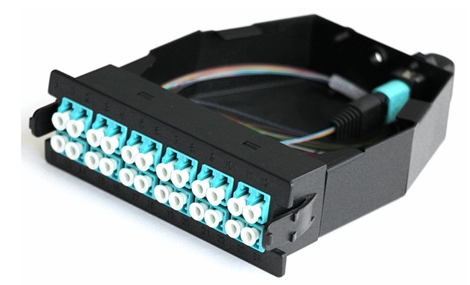What is an MTP / MPO connector?
What does an MPO connector do? What are the typical use cases for an MPO cable? How does an MTP connector differ from an MPO connector and how do you determine if you're holding a male or female plug? A heated office discussion a few weeks ago is the inspiration for this post.
An MPO patchcable
MPO stands for Multi-fibre Push On and it's an standardized interface type. As the name suggests this connector was specifically designed to hold multiple optical fibers. IEC 61754-7-1 defines an MPO connector with 1 fiber row, IEC 61754-7-2 adds a second row of glass. In daily use you will only come across 12- or 24 Single or Multimode fiber MPO cables. But you can find assemblies with as much as 144 fibers. Those high numbers are achieved by creating a fan-out cable with multiple MPO connectors at each end.
MTP vs. MPO
MTP is not a standard, it's in fact a registered trademark of US Conec. MTP connectors have a number of mechanical improvements over standard MPO connectors but they are fully compatible. In daily operations the terms are often used interchangeably or along side each other, i.e. MTP/MPO connector.
Male vs. female
Close-up showing the difference between a male and female MPO Connector
A male MPO connector has 2 metal pins. These pins line up with 2 holes on the female connector. The pins ensure proper optical alignment. MPO interfaces on optical transceivers are always male (pinned). To avoid damage to the optical module MPO patch cable gender must therefor always be female (unpinned) on both ends.
Male patch cords are only used when you combine multiple MPO patch cables together. Mating up two males or two females connectors is never a good idea. Either the fibers won't be aligned properly (two females) or they won't be connected at all (two males).
Polarity
MPO Type A, Type B and Type C Cables
In optical connections the transmitter of one device needs to be connected to the receiver of the other and vice versa. Typically this means the fibers need to be crossed at some point along the link. Three different MPO cable polarities exist to help you design your cable plant.
- MPO Trunk Cable Type-A or Straight: On a Type-A cable the fibers at each end of the cable have the same fiber position.
- MPO Trunk Cable Type-B or Reversed: On a Type-B cable the fiber positions are reversed at each end. On a 12-fiber cable this means the P1 on one end connects to P12 on the other end.
- MPO Trunk Cable Type-C or Pairs flipped: Type-C cables cross each adjacent pair. So P1 on one end connects to P2 on the other end. This may be useful when you use MPO Trunk cables to aggregate several duplex fiber pairs. Type-C cables are completely inappropriate for 40 or 100 Gbps applications where all fiber strands terminate on the same device.
Aggregating duplex fibers with cassettes
An MPO cassette can break out 24 fibers to 12 duplex LC ports.
Changing polarity in LC (or SC) cables through an A/B patch cord.
Very often MPO cabling is used to interconnect two data center racks by aggregating multiple duplex SC or LC connections into an MPO cassette. Changing the polarity can also be done through the adapter in the back of these MPO cassettes or loose MPO adapters that combine two separate MPO cables or by using one straight and one crossed duplex fiber going into your transceivers at the edge.
Final thoughts
Incorrect cabling issues such as inverted polarities are some of simplest but also most common issues in the data center. I recommend to have as few cable types as possible inside any data center to avoid mix-ups. The exact policies for your environment will always depend on your use case and your history but you should consider the following:
- Use Single Mode fiber only so there can be no mix ups in patch panels, patch cords or SFPs. Long Range (Single Mode) SFPs for 1 Gbps and 10 Gbps are still marginally more expensive than Short Range SFPs but totally worth it considering the operational simplicity.
- Only use and stock female MPO cables of all necessary lengths so there can be confusion or damage.
- Only use and stock reversed fiber cables, i.e. A/B SC/LC patch cords and Type-B MPO cables.
- The cross-over SC/LC patch cables are what you typically need to interconnect two devices at 1 or 10 Gbps, the Type-B MPO cable interconnects two devices at 40 or 100 Gbps.
- Even when you use MPO cassettes in your racks, the fibers will be inverted 3 times (twice in the SC/LC cabling and once in the MPO cable between the two cassettes) meaning that the end-result is still inverted as expected.
- Always check the transceiver specifications for the number of fibers in the MPO cable it will use, either 12 or 24.







